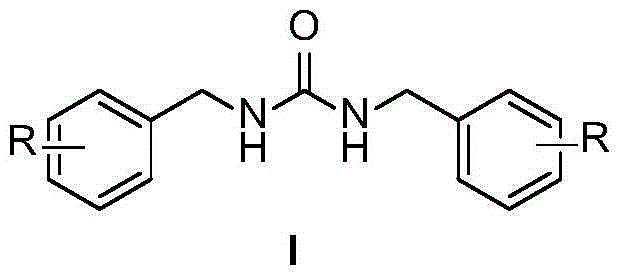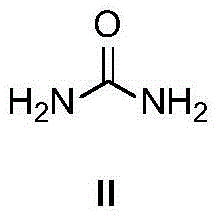Method for synthesizing N,N'-dialkylurea
A dialkyl urea compound technology, applied in the field of organic synthetic chemistry, can solve the problems of low atom economy, high toxicity of isocyanate, damage to the environment and equipment, etc., and achieve the effect of broad development prospects
- Summary
- Abstract
- Description
- Claims
- Application Information
AI Technical Summary
Problems solved by technology
Method used
Image
Examples
Embodiment 1
[0019] Embodiment 1: 1,3-benzhydryl urea
[0020] 1,3-dibenzylurea
[0021]
[0022] Urea (60.06mg, 1mmol), [Cp*IrCl 2 ] 2 (3.2mg, 0.04mmol, 0.4mol%) and sodium hydroxide (40mg, 1mmol), benzyl alcohol (108.14mg, 1mmol) and 1ml tert-amyl alcohol were sequentially added to a 10ml microwave reaction flask. After the reaction mixture was reacted at 110°C for 3 hours, it was cooled to room temperature, the solvent was removed by rotary evaporation, and then the pure target compound was obtained by column chromatography (developing solvent: ethyl acetate / petroleum ether), yield: 85% 1 H NMR (500MHz, CDCl 3 )δ7.30-7.28(m,4H,ArH),7.26-7.23(m,6H,ArH),4.89(t,J=5.0Hz,2H,AlkylNH),4.33(d,J=5.7Hz,4H, 2xCH 2 ); 13 C NMR (125MHz, CDCl 3 )δ158.4, 139.2, 128.5, 127.3, 127.2, 44.4.
Embodiment 2
[0023] Example 2: 1,3-bis(4-methoxy)benzylurea
[0024] 1,3-bis(4-methoxybenzyl)urea
[0025]
[0026] Urea (60.06mg, 1mmol), [Cp*IrCl 2 ] 2 (3.2mg, 0.04mmol, 0.4mol%) and sodium hydroxide (40mg, 1mmol), p-methoxybenzyl alcohol (138.16mg, 1mmol) and 1ml tert-amyl alcohol were added to a 10ml microwave reaction flask in turn. After the reaction mixture was reacted at 110°C for 3 hours, it was cooled to room temperature, the solvent was removed by rotary evaporation, and then the pure target compound was obtained by column chromatography (developing solvent: ethyl acetate / petroleum ether), yield: 86%
[0027] 1,3-bis(4-methoxybenzyl)urea(5ka).mp176-177℃; 1 H NMR (500MHz,DMSO)δ7.17(s,4H,ArH),6.87(s,4H,ArH),6.29(s,2H,AlkylNH),4.14(s,4H,CH 2 ),3.72(s,6H,OCH 3 ); 13 C NMR (125MHz, DMSO) δ158.0, 157.9, 132.7, 128.3, 113.6, 55.0, 42.4.
Embodiment 3
[0028] Example 3: 1,3-bis(4-trifluoromethyl)benzylurea
[0029] 1,3-bis(4-(trifluoromethyl)benzyl)urea
[0030]
[0031] Urea (60.06mg, 1mmol), [Cp*IrCl 2 ] 2 (3.2mg, 0.04mmol, 0.4mol%) and sodium hydroxide (40mg, 1mmol), p-trifluorobenzyl alcohol (176.14mg, 1mmol) and 1ml tert-amyl alcohol were sequentially added to a 10ml microwave reaction flask. After the reaction mixture was reacted at 110°C for 3 hours, it was cooled to room temperature, the solvent was removed by rotary evaporation, and then the pure target compound was obtained by column chromatography (developing solvent: ethyl acetate / petroleum ether), yield: 75%
[0032] mp170-171℃; 1 H NMR (500MHz, DMSO-d 6 )δ7.68(d,J=7.3Hz,4H,ArH),7.46(d,J=7.2Hz,4H,ArH),6.68(t,J=5.4Hz,2H,AlkylNH),4.31(d,J =4.8Hz,4H,CH 2 ); 13 CNMR (125MHz, DMSO-d 6 )δ158.0, 145.9, 127.5, 127.2 (q, J C-F =31.6Hz),125.0(d,J C-F =3.5Hz),124.3(q,J C-F =270Hz), 42.6.
PUM
 Login to View More
Login to View More Abstract
Description
Claims
Application Information
 Login to View More
Login to View More - R&D
- Intellectual Property
- Life Sciences
- Materials
- Tech Scout
- Unparalleled Data Quality
- Higher Quality Content
- 60% Fewer Hallucinations
Browse by: Latest US Patents, China's latest patents, Technical Efficacy Thesaurus, Application Domain, Technology Topic, Popular Technical Reports.
© 2025 PatSnap. All rights reserved.Legal|Privacy policy|Modern Slavery Act Transparency Statement|Sitemap|About US| Contact US: help@patsnap.com



